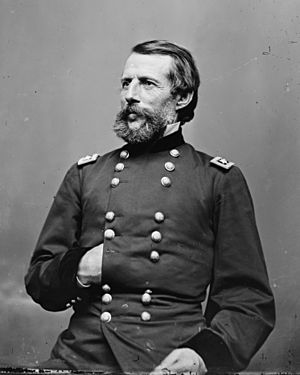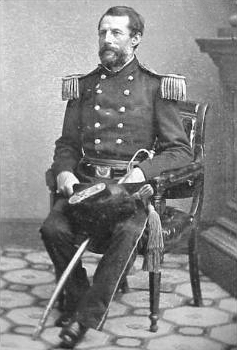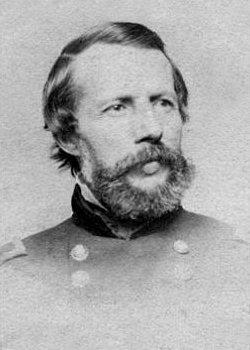Erasmus D. Keyes facts for kids
Quick facts for kids
Erasmus Darwin Keyes
|
|
|---|---|

Erasmus D. Keyes
|
|
| Born | May 29, 1810 Brinfield, Massachusetts |
| Died | October 14, 1895 (aged 85) Nice, France |
| Place of burial |
West Point Cemetery
|
| Allegiance | United States of America Union |
| Service/ |
United States Army Union Army |
| Years of service | 1832–1864 |
| Rank | |
| Commands held | IV Corps |
| Battles/wars | Indian Wars |
Erasmus Darwin Keyes (born May 29, 1810 – died October 14, 1895) was an important American general. He was also a businessman and banker. General Keyes is best known for leading the IV Corps of the Union Army during the first part of the American Civil War.
Contents
Early Life and Military Start
Keyes was born in Brimfield, Massachusetts. When he was young, his family moved to Kennebec County, Maine. His father was a famous doctor. But Erasmus chose a military path instead.
He joined the United States Military Academy at West Point. He graduated in 1832, ranking 10th in his class. He became a second lieutenant in the 3rd U.S. Artillery.
Early Military Service
Keyes served in Charleston Harbor from 1832 to 1833. This was during a time of political tension called the nullification crisis. He then worked as an aide to General Winfield Scott from 1837 to 1841.
Keyes was promoted to captain on November 30, 1841. He served in various army posts until 1844. After that, he taught artillery and cavalry at West Point.
Service in the West
In 1854, Keyes and his regiment sailed around Cape Horn to California. He served on the Pacific frontier until 1860. He was involved in garrison duty and military campaigns.
Keyes served in the Pacific Northwest starting in 1855. This was during the Puget Sound War. His artillery company was sent to Fort Steilacoom. In January 1856, he tried twice to capture Chief Leschi, but he did not succeed.
On March 4, 1856, Keyes and 100 soldiers fought a battle. It took place at the White River and Muckleshoot Prairie.
Spokane – Coeur d'Alene – Paloos War
During the Spokane – Coeur d'Alene – Paloos War, Captain Keyes went ahead of the main army. He helped set up Fort Taylor. He also created a ferry crossing over the Snake River for Colonel George Wright's army.
In the campaign that followed, Keyes led four companies of artillerymen. They were armed with rifles. They fought against allied Native American tribes at the Battle of Four Lakes. Soon after this battle, Keyes became a major on October 12, 1858.
General Scott then made Keyes his military secretary. Keyes held this job from January 1, 1860, until April 1861.
American Civil War Service
When the Civil War began, Keyes was promoted to colonel on May 14, 1861. He briefly worked for New York Governor Edwin D. Morgan. He helped organize the state's militia.
At the First Battle of Bull Run, Keyes commanded a brigade. He later took command of a division. In August 1861, he was promoted to brigadier general. He was one of the highest-ranking brigadier generals in the army.
On March 14, 1862, President Lincoln organized the Army of the Potomac into corps. Keyes was given command of the new IV Corps.
Peninsula Campaign
General George B. McClellan planned the Peninsula Campaign in 1862. This campaign aimed to capture Richmond, the Confederate capital. Keyes led his corps well during this campaign.
Keyes fought in many battles during this time. These included:
- Lee's Mill
- Yorktown
- Bottom's Bridge
- Savage's Station
- Seven Pines (also called Fair Oaks)
- Charles City Cross Roads
- Malvern Hill
- Harrison's Landing
For his bravery at Fair Oaks, Keyes was recognized as a brigadier general in the regular army. After the Seven Days Battles, General McClellan promoted many commanders to major general. However, Keyes remained a brigadier general.
In August, Keyes and one division of his corps stayed on the Peninsula. They became part of General John Adams Dix's Department of the James.
On March 12, 1863, President Abraham Lincoln nominated Keyes for promotion. He became a major general of U.S. Volunteers. The U.S. Senate confirmed this on March 13, 1863.
Besides the IV Corps, he also commanded other areas. These included the Yorktown District and the VII Corps. He also led the division at Suffolk. Keyes also took part in a raid to White House, Virginia, in January 1863. He also led an expedition to West Point, Virginia, in May 1863.
Removal from Command
During the Gettysburg Campaign in 1863, Keyes had a disagreement with General John Adams Dix. Dix wanted to make a strong show of force against Richmond. This was to draw Confederate soldiers away from General Robert E. Lee's army in Pennsylvania.
Keyes pulled back from a position near what is now Talleysville, Virginia. Dix believed Keyes retreated from weaker forces. Because of this, Dix removed Keyes from his command.
Keyes asked for an investigation into the charges against him. But his request was never granted. He then served on various military boards. He retired from the army on May 6, 1864.
Life After the War
After the war, Keyes moved to San Francisco. He became very successful in business and was well-known. He became a member of the Catholic Church in 1866.
From 1867 to 1869, he was president of a Mexican gold mining company. He was also vice president of a California wine-growing society from 1868 to 1872. He also worked in the savings and loan business.
General Keyes joined the California Commandery of the Military Order of the Loyal Legion of the United States. This was a society for Union officers and their families.
Keyes also wrote several books. These included The Rear Guard at Malvern Hill, which was part of a Civil War series. He also wrote Fifty Years' Observation of Men and Events (1884). This book was later reprinted as Fighting Indians in Washington Territory. His work From West Point to California was published after he died in 1950.
Keyes died in Nice, France, at age 85. He was on a trip to Europe with his wife. He is buried in West Point Cemetery.
See also
 In Spanish: Erasmus D. Keyes para niños
In Spanish: Erasmus D. Keyes para niños



